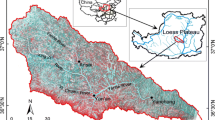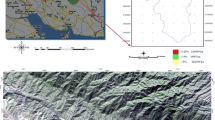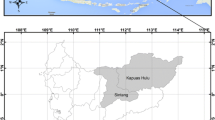Abstract
The Cerrado is a biome in Brazil that is experiencing the most rapid loss in natural vegetation. The objective of this study was to analyze the changes in the spectral response in the red, near infrared (NIR), middle infrared (MIR), and normalized difference vegetation index (NDVI) when native vegetation in the Cerrado is deforested. The test sites were regions of the Cerrado located in the states of Bahia, Minas Gerais, and Mato Grosso. For each region, a pair of Landsat Thematic Mapper (TM) scenes from 2008 (before deforestation) and 2009 (after deforestation) was compared. A set of 1,380 samples of deforested polygons and an equal number of samples of native vegetation have their spectral properties statistically analyzed. The accuracy of deforestation detections was also evaluated using high spatial resolution imagery. Results showed that the spectral data of deforested areas and their corresponding native vegetation were statistically different. The red band showed the highest difference between the reflectance data from deforested areas and native vegetation, while the NIR band showed the lowest difference. A consistent pattern of spectral change when native vegetation in the Cerrado is deforested was identified regardless of the location in the biome. The overall accuracy of deforestation detections was 97.75 %. Considering both the marked pattern of spectral changes and the high deforestation detection accuracy, this study suggests that deforestation in Cerrado can be accurately monitored, but a strong seasonal and spatial variability of spectral changes might be expected.






Similar content being viewed by others
References
ANA. (2013). Sistema de Informações Hidrológicas—HIDROWEB. Brasília: Agência Nacional de Águas. Available at http://hidroweb.ana.gov.br/ (accessed 11 November 2012).
Asner, G. P. (1998). Biophysical and biochemical sources of variability in canopy reflectance. Remote Sensing of Environment, 64, 234–253.
Batlle-Bayer, L., Batjes, N. H., & Bindraban, P. S. (2010). Changes in organic carbon stocks upon land use conversion in the Brazilian Cerrado: a review. Agriculture, Ecosystems & Environment, 137, 47–58.
Bernoux, M., Cerri, C. C., Cerri, C. E. P., Siqueira Neto, M., Metay, A., Perrin, A. S., Scopel, E., Razafimbelo, T., Blavet, D., Piccolo, M. D. C., Pavei, M., & Milne, E. (2006). Cropping systems, carbon sequestration and erosion in Brazil, a review. Agronomy for Sustainable Development, 26, 1–8.
Bridgewater, S., Ratter, J. A., & Ribeiro, J. F. (2004). Biogeographic patterns, β-diversity and dominance in the Cerrado biome of Brazil. Biodiversity and Conservation, 13, 2295–2318.
Brown, J. C., Kastens, J. H., Coutinho, A. C., Victoria, D. C., & Bishop, C. R. (2013). Classifying multiyear agricultural land use data from Mato Grosso using time-series MODIS vegetation index data. Remote Sensing of Environment, 130, 39–50.
Butler, A., Meir, P., Saiz, G., Maracahipes, L., Marimon, B. S., & Grace, J. (2012). Annual variation in soil respiration and its component parts in two structurally contrasting woody savannas in Central Brazil. Plant and Soil, 352, 129–142.
Castro, E. A., & Kauffman, J. B. (1998). Ecosystem structure in the Brazilian Cerrado: a vegetation gradient of aboveground biomass, root mass and consumption by fire. Journal of Tropical Ecology, 14, 263–283.
Cianciaruso, M. V., Batalha, M. A., & Silva, I. G. A. (2005). Seasonal variation of a hyperseasonal Cerrado in Emas National Park, central Brazil. Flora, 200, 345–353.
Eva, H. D., Belward, A. S., Miranda, E. E., Di Bella, C. M., Gond, V., Huber, O., Jones, S., Sgrenzaroli, M., & Fritz, S. (2004). A land cover map of South America. Global Change Biology, 10, 731–744.
Ferreira, L. G., & Huete, A. R. (2004). Assessing the seasonal dynamics of the Brazilian Cerrado vegetation through the use of spectral vegetation indices. International Journal of Remote Sensing, 25, 1837–1860.
Ferreira, L. G., Yoshioka, H., Huete, A., & Sano, E. E. (2003). Seasonal landscape and spectral vegetation index dynamics in the Brazilian Cerrado: an analysis within the large-scale biosphere–atmosphere experiment in Amazonia (LBA). Remote Sensing of Environment, 87, 534–550.
Foody, G. M. (2003). Geographical weighting as a further refinement to regression modelling: an example focused on the NDVI–rainfall relationship. Remote Sensing of Environment, 88, 283–293.
Furley, P. A. (1999). The nature and diversity of neotropical savanna vegetation with particular reference to the Brazilian Cerrados. Global Ecology and Biogeography, 8, 223–241.
Galford, G. L., Mustard, J. F., Melillo, J., Gendrin, A., Cerri, C. C., & Cerri, C. E. P. (2008). Wavelet analysis of MODIS time series to detect expansion and intensification of row-crop agriculture in Brazil. Remote Sensing of Environment, 112, 576–587.
Giambelluca, T. W., Scholz, F. G., Bucci, S. J., Meinzer, F. C., Goldstein, G., Hoffmann, W. A., Franco, A. C., & Buchert, M. P. (2009). Evapotranspiration and energy balance of Brazilian savannas with contrasting tree density. Agricultural and Forest Meteorology, 149, 1365–1376.
Hill, M. J., Roman, M. O., Schaaf, C. B., Hutley, L., Brannstrom, C., Etter, A., & Hanan, N. P. (2011). Characterizing vegetation cover in global savannas with an annual foliage clumping index derived from the MODIS BRDF product. Remote Sensing of Environment, 115, 2008–2024.
Huete, A., Didan, K., Miura, T., Rodriguez, E. P., Gao, X., & Ferreira, L. G. (2002). Overview of the radiometric and biophysical performance of the MODIS vegetation indices. Remote Sensing of Environment, 83, 195–213.
IBAMA. (2013). Projeto de Monitoramento do Desmatamento dos Biomas Brasileiros por Satélite (PMDBBS). Brasília: IBAMA. Available at http://siscom.ibama.gov.br/monitorabiomas/ (accessed 15 February 2013).
IBGE. (2004). Mapa de biomas do Brasil (Escala 1:5.000.000). Rio de Janeiro: IBGE. Available at http://mapas.ibge.gov.br/biomas2/viewer.htm (accessed 15 December 2012).
Ichii, K., Kawabata, A., & Yamaguchi, Y. (2002). Global correlation analysis for NDVI and climatic variables and NDVI trends: 1982–1990. International Journal of Remote Sensing, 23, 3873–3878.
INPE. (2013). Projeto PRODES. Monitoramento da Floresta Amazônica Brasileira por Satélite. São José dos Campos: INPE. Available at http://www.obt.inpe.br/prodes/index.php (accessed 11 December 2012).
Jensen, J. R. (2006). Remote sensing of the environment: an earth resource perspective (2nd ed., p. 608). Upper Saddle River: Prentice Hall.
Jepson, W., Brannstrom, C., & Filippi, A. (2010). Access regimes and regional land change in the Brazilian Cerrado, 1972–2002. Annals of the Association of American Geographers, 100, 87–111.
Liesenberg, V., Galvão, L. S., & Ponzoni, F. J. (2007). Variations in reflectance with seasonality and viewing geometry: implications for classification of Brazilian savanna physiognomies with MISR/Terra data. Remote Sensing of Environment, 107, 276–286.
Mendes, I. C., Fernandes, M. F., Chaer, G. M., & Reis Junior, F. B. (2012). Biological functioning of Brazilian Cerrado soils under different vegetation types. Plant and Soil, 359, 183–195.
MMA. (2007). Mapeamento de Cobertura Vegetal do Bioma Cerrado—Relatório Final. Brasília, MMA, Available at http://mapas.mma.gov.br/geodados/brasil/ vegetacao/vegetacao2002/cerrado/documentos/relatorio_final.pdf>. Accessed 13 January 2013.
MMA. (2009). Relatório técnico de monitoramento do desmatamento no bioma Cerrado, 2002–2008: dados revisados. Brasilia: MMA. Available at http://www.mma.gov.br/estruturas/sbf_chm_rbbio/_arquivos/relatorio_tecnico_monitoramento_desmate_bioma_cerrado_csr_ibama_2002_2008_rev_72.pdf (accessed 13 July 2012).
Myers, N., Mittermeier, R. A., Mittermeier, C. G., Fonseca, G. A. B., & Kent, J. (2000). Biodiversity hotspots for conservation priorities. Nature, 403, 853–858.
Oliveira-Filho, A. T., & Ratter, J. A. (2002). Vegetation physiognomies and woody flora of the Cerrado biome. In P. S. Oliveira & R. J. Marquis (Eds.), The Cerrados of Brazil: ecology and natural history of a neotropical savanna (pp. 91–120). New York: Columbia University Press.
Philippi, A. M., Brannstrom, C., Dobreva, I., Cairns, D. M., & Kim, D. (2009). Unsupervised fuzzy ARTMAP classification of hyperspectral hyperion data for savanna and agriculture discrimination in the Brazilian Cerrado. GIScience & Remote Sensing, 46, 1–23.
Rada, N. (2013). Assessing Brazil’s Cerrado agricultural miracle. Food Policy, 38, 146–155.
Ratana, P., Huete, A. R., & Ferreira, L. (2005). Analysis of Cerrado physiognomies and conversion in the MODIS seasonal–temporal domain. Earth Interactions, 9, 1–22.
Ratter, J. A., Ribeiro, J. F., & Bridgewater, S. (1997). The Brazilian Cerrado vegetation and threats to its biodiversity. Annals of Botany, 80, 23–230.
Ratter, J. A., Bridgewater, S., & Ribeiro, J. F. (2006). Biodiversity patterns of the woody vegetation of the Brazilian Cerrados. In T. Penington & J. A. Ratter (Eds.), Neotropical savannas and seasonally dry forests (pp. 31–66). Boca Raton: CRC Press.
Ribeiro, J. F., & Walter, B. M. T. (2008). Fitofisionomias do bioma Cerrado. In S. M. Sano, S. P. Almeida, & J. F. Ribeiro (Eds.), Cerrado: Ambiente e Flora (pp. 151–199). Embrapa-CPAC: Planaltina.
Saatchi, S. S., Harris, N. L., Brown, S., Lefsky, M., Mitchard, E. T. A., Salas, W., Zutta, B. R., Buermannn, W., Lewis, S. L., Hagen, S., Petrova, S., White, L., Silman, M., & Morel, A. (2011). Benchmark map of forest carbon stocks in tropical regions across three continents. Proceedings of the National Academy of Sciences, 108, 9899–9904.
Sano, E. E., Barcellos, A. O., & Bezerra, H. S. (2001). Assessing the spatial distribution of cultivated pastures in the Brazilian savanna. Pasturas Tropicales, 22, 2–15.
Sano, E. E., Rosa, R., Brito, J. L. S., & Ferreira, L. G. (2008). Mapeamento semidetalhado do uso da terra do Bioma Cerrado. Pesquisa Agropecuária Brasileira, 43, 153–156.
Sano, E. E., Rosa, R., Brito, J. L., & Ferreira, L. G. (2010). Land cover mapping of the tropical savanna region in Brazil. Environmental Monitoring and Assessment, 166, 113–124.
Sano, E. E., Santos, C. C. M., Silva, E. M., & Chaves, J. M. (2011). Fronteira agrícola do oeste baiano: considerações sobre os aspectos temporais e ambientais. Geociências, 30, 479–489.
Silva, J. M. C., & Bates, J. M. (2002). Biogeographic patterns and conservation in the South American Cerrado: a tropical savanna hotspot. Bioscience, 52, 225–234.
Silva, J. F., Farinas, M. R., Felfili, J. M., & Klink, C. A. (2006). Spatial heterogeneity, land use and conservation in the Cerrado region of Brazil. Journal of Biogeography, 33, 536–548.
Simon, M. F., Grether, R., Queiroz, L. P., Skema, C., Pennington, R. T., & Hughes, C. E. (2009). Recent assembly of the Cerrado, a neotropical plant diversity hotspot, by in situ evolution of adaptations to fire. Proceedings of the National Academy of Sciences, 106, 20359–20364.
Song, Y., & Ma, M. (2011). A statistical analysis of the relationship between climatic factors and the normalized difference vegetation index in China. International Journal of Remote Sensing, 32, 3947–3965.
Tucker, C. J. (1979). Red and photographic infrared linear combinations for monitoring vegetation. Remote Sensing of Environment, 8, 127–150.
Author information
Authors and Affiliations
Corresponding author
Rights and permissions
About this article
Cite this article
Trancoso, R., Sano, E.E. & Meneses, P.R. The spectral changes of deforestation in the Brazilian tropical savanna. Environ Monit Assess 187, 4145 (2015). https://doi.org/10.1007/s10661-014-4145-3
Received:
Accepted:
Published:
DOI: https://doi.org/10.1007/s10661-014-4145-3




